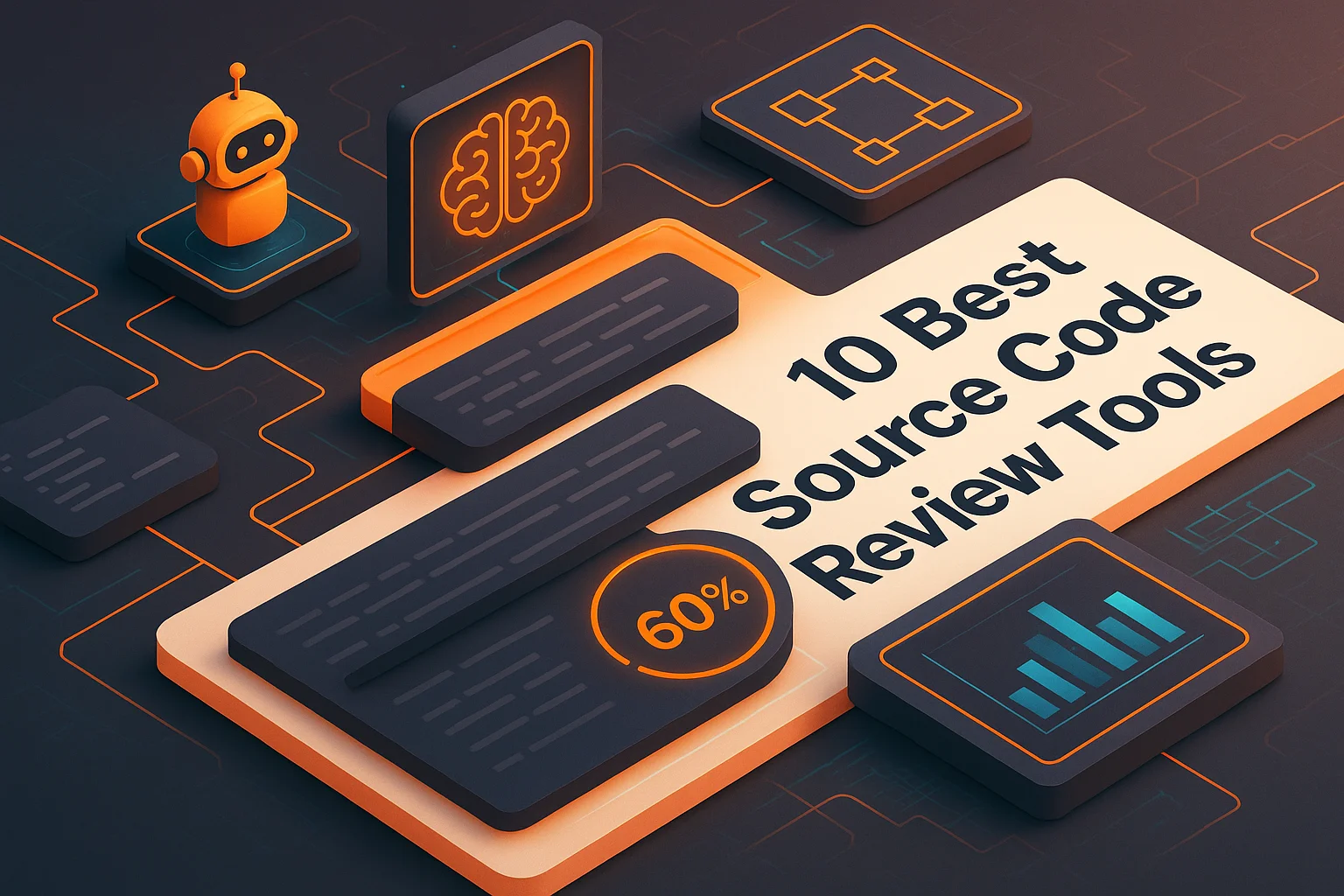Top 9 Automated Code Review Tools for Engineering Teams

Automated code review moved from a side project to a frontline engineering requirement in 2025. Between sprawling monorepos, complex compliance rules, and AI generated code, teams now rely on automated reviewers to triage risk before a human ever opens the pull request. This updated guide profiles nine standout tools and explains how to assemble a stack that covers GitHub workflows, open source flexibility, and rigorous governance.
We pulled data from conversations with enterprise teams using automation blueprints and compared notes with our guides on async review and security ownership. The result is a practical playbook: where each tool fits, which KPIs it boosts, and how to evaluate signal quality before rolling anything out org wide.
Quick takeaways
- GitHub ready by default: Six of the nine vendors ship native GitHub App installs, so platform teams can enforce branch policies without brittle webhooks.
- Open source options matter: Self-hosted teams pick SonarQube, Review Board, or the open core Snyk Code engine. They suit regulated industries or data residency requirements.
- Pair AI with deterministic checks: Layering AI review (Propel Code, Code Climate, Codacy) on top of static analysis reduces noise and shortens lead times when paired with autofix.
- Buying criteria changed: Teams now score tools on review latency, percentage of automated fixes merged, and explainability rather than a raw list of rules.
Comparison snapshot: automated review tools at a glance
Use the matrix below as a starting point before running a proof of concept with your own pull request corpus. Pricing references public 2025 list rates for mid market teams.
| Tool | Pricing signal | GitHub focus | Open source | Notable strengths |
|---|---|---|---|---|
| Propel Code | Usage-based with AI seat bundles | Deep GitHub integration plus REST API | Closed source SaaS | Contextual AI review, policy automation, reviewer analytics |
| GitHub Advanced Security | Enterprise add-on | Native. Runs inside GitHub Actions | Closed source | Secret scanning, Dependabot, CodeQL security workflows |
| SonarQube | Community free. Enterprise tiers scale per LOC | Integrates through GitHub App and checks | Community open source | 30+ language coverage, quality gates, technical debt tracking |
| Code Climate Velocity | Per user with engineering analytics | Strong GitHub insights dashboards | Closed source | PR quality scores, reviewer workload, automated refactoring cues |
| Veracode | Enterprise contracts | Integrates through pipelines and IDE plugins | Closed source | Compliance reporting, application security testing, policy gates |
| Snyk Code (DeepCode) | Free tier. Paid per seat | GitHub App plus CLI | Scanner core open sourced | AI assisted vulnerability detection with autofix |
| Embold | Team and enterprise plans | GitHub App with design issue detection | Closed source | Anti pattern detection, maintainability scoring, SaaS or on prem |
| Codacy | Per user, generous free tier | GitHub, GitLab, Bitbucket parity | Closed source | Customizable rulesets, coverage tracking, AI generated suggestions |
| Review Board | Open source with paid support | Connects via webhooks and API | Fully open source | Custom workflows, document review, flexible self hosting |
Why these nine tools stand out in 2025
The landscape is crowded, yet these platforms consistently appear in RFQs and conversations with staff engineers. Each brings a distinct lens: some focus on AI copilots for reviewers, others ensure security and compliance, while a few make the shortlist thanks to permissive licenses.
1. Propel Code: AI powered intelligent reviews with human context
Propel Code pairs project-aware large language models with policy automation so teams can trust fast approvals. It learns codebase idioms, references ownership maps, and shows reviewers a structured brief that summarizes intent, risk areas, and recommended tests. Platform teams like the usage analytics that identify burnout and surface repos with high review drag. Propel Code pipelines also connect to security scanners, letting you promote automated fixes to production when confidence clears a threshold.
- Native GitHub App with checks, summary review, and inline comments
- Supports custom prompts and compliance policies per service or directory
- Insights dashboard highlights cycle time, review load, and bot acceptance rate
2. GitHub Advanced Security: security posture baked into your repos
Most GitHub Enterprise accounts already own Advanced Security seats. You gain secret scanning, Dependabot updates, and CodeQL queries that run on every pull request. Security teams appreciate the audit trail and automated enforcement with GitHub Rulesets. While it is primarily security focused, pairing it with Propel Code or Codacy covers maintainability and logic bugs that static analysis misses.
3. SonarQube: the baseline for static code analysis
SonarQube remains the reference implementation for language coverage and quality gates. The open source edition lets teams pilot on a self hosted server while enterprise tiers add SSO, branch analysis, and compliance reports. Many organizations keep SonarQube as the deterministic safety net with AI reviewers layered on top.
4. Code Climate Velocity: insights into developer health
Velocity blends automated review comments with engineering analytics. It scores pull requests, highlights when review debt accumulates, and suggests refactors that improve maintainability. The GitHub integration is deep, syncing team structures and sprint cadences.
5. Veracode: compliance grade application security
Enterprises in finance and healthcare lean on Veracode for its certifications and executive dashboards. It embeds policy gates in CI pipelines, scans binaries, and integrates with IDEs to coach developers before they push. Expect longer onboarding but strong alignment with regulatory audits.
6. Snyk Code (DeepCode): developer friendly security fixes
The DeepCode engine became Snyk Code and now ships as both SaaS and a self hosted option. Teams appreciate the autofix suggestions in pull requests and IDEs. The open core approach gives security teams transparency while the paid tier adds fleet management and policy control.
7. Embold: architectural issue detection
Embold visualizes code smells that accumulate over years of feature work. The platform identifies cyclic dependencies, god classes, and complexity hot spots. For GitHub users the App posts actionable comments with remediation advice instead of raw metrics.
8. Codacy: coverage and quality guardrails with AI assist
Codacy monitors quality gates across repos and pairs classic static analysis with newer AI generated remediation guidance. The rulesets are fully customizable, making it a solid option for startups and mid market teams standardizing linting across languages.
9. Review Board: open source oversight for regulated environments
Review Board is the veteran open source code review platform. It shines when legal or compliance teams need to inspect reviews, sign off on documents, or host the system behind a corporate firewall. Its extension framework lets platform teams build custom approval requirements without waiting on vendor roadmaps.
Answering top buying questions
What are the best GitHub code review platforms?
GitHub centric teams usually shortlist Propel, GitHub Advanced Security, Codacy, and Snyk Code. All four offer GitHub App installs, status checks, and inline review comments. Propel adds AI generated summaries and policy routing, while Advanced Security and Snyk focus on catching vulnerabilities before merge. Combine them if you want both logic coverage and hardened security workflows.
Which automated review tools are open source?
SonarQube Community Edition, Snyk Code's analyzer, and Review Board provide genuine open source paths. They fit teams with data residency rules, air gapped environments, or budgets that favor customization over vendor lock in. Remember to budget engineering time for upgrades and rule tuning, since these deployments rely on your platform team for upkeep.
How should teams evaluate automated code review tools?
Start with quantitative baselines: pull request cycle time, number of manual review comments, and escape defect rate. During a proof of concept track the percentage of automated suggestions merged without edit, reviewer trust scores from surveys, and any regressions in velocity. Favor tools that surface rationales, link to documentation, and provide sandbox environments for experimentation.
Evaluation checklist
- Does the tool return feedback before reviewers enter the diff?
- Can you tune rules per repository, service, or compliance regime?
- How transparent are AI generated comments and suggested fixes?
- What telemetry helps you prove ROI to executives each quarter?
- Will developers trust the tool enough to merge automated fixes?
Best practices for rolling out automated code review
Even best in class software can create backlash if the rollout ignores change management. We captured the lessons below while helping customers launch automated review programs across hundreds of repositories.
- Pilot with a willing squad: Choose teams that own well understood services and value experimentation. Use their metrics as the internal case study before scaling.
- Publish policies as code: Store review requirements in version control so developers understand why bots block merges and can propose updates through pull requests.
- Blend AI with human reviewers: Keep senior engineers focused on high risk architectural decisions while AI handles rote checks and context summaries.
- Instrument feedback loops: Collect developer satisfaction scores, track how often reviewers accept automated fixes, and review noisy rules every sprint.
- Create enablement paths: Pair lunch and learns with written runbooks, referencing guides like our code review checklist to level up new contributors.
Automated review is not a silver bullet, but when you align technology, process, and training it becomes a competitive advantage. Start with a lightweight bake off, measure outcomes, and keep iterating until the bulk of low risk diffs merge without human toil. Then reinvest the saved cycles into deeper design reviews, onboarding, and the strategic work only your engineers can ship.
Ready to Transform Your Code Review Process?
See how Propel's AI-powered code review helps engineering teams ship better code faster with intelligent analysis and actionable feedback.


